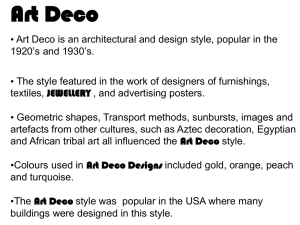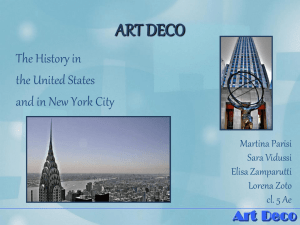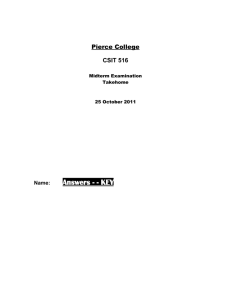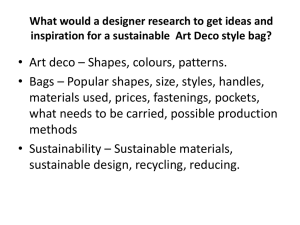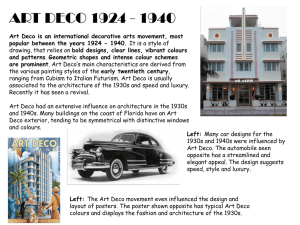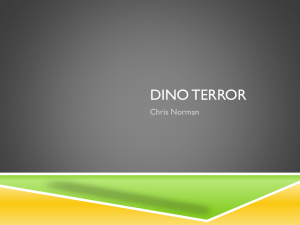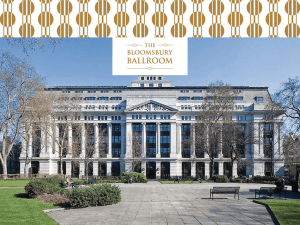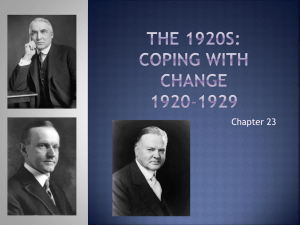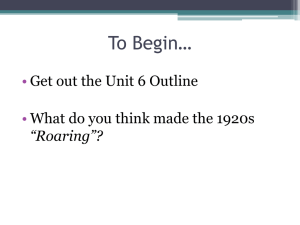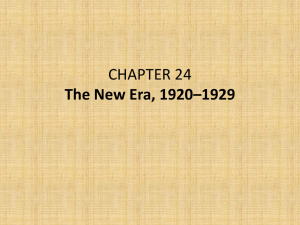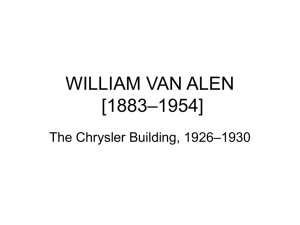Art Deco (1920`s-1930`s) - Server Home Page > Home
advertisement
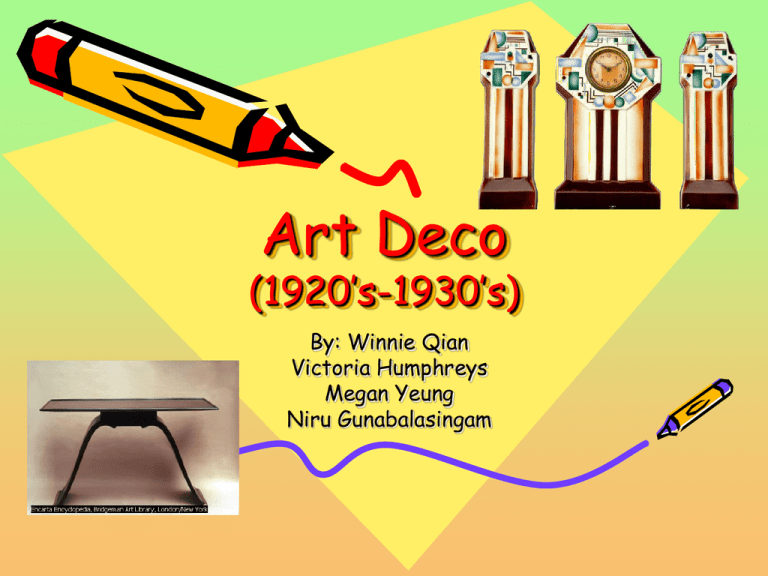
Art Deco (1920’s-1930’s) By: Winnie Qian Victoria Humphreys Megan Yeung Niru Gunabalasingam Art Deco • Popular in 1920’s and 1930’s (immediately after WWI) • New mood for a rigorous, clean-cut look • Spread through every aspect of daily life between wars – – – – – – – Fashion Art Furniture Sculpture Jewelry Technology Architecture • • • • • • • Art Deco Design of building, furniture, jewelry and interior décor Modern through it’s: – Abstract design – Colour – Use of nature for inspiration – Portraying animals – Beauties of the female form Sleek, symmetrical streamlined forms Elegance and sophistication Celebrated: – Rise of commerce – Technology – Speed Used abstraction, distortion & simplification Flapper, the Jazz and the Machine Age Materials – Rubies – Gold – Pearls – Plastic – Chrome – Steel More accessible compared to previous styles Art Deco • - First true 20th century style - International - Style could be adapted to every single man-made object - Arrived at a time when new technology/ communication ensured rapid spread - Last total style • E.g. could ornament a house, yacht or knife • Influences: – – – – – – – Influences Pharaonic Egypt Orient Tribal Africa Cubism Futurism Machines Graphic Design • Later named after Exposition des Arts Décoratifs et Industriels Moderns held in Paris in 1925 Art • Took place between the 1920s and 1930s • After the social and economic pressures of WWI • Definition was an innovative design style • Common designs in art deco consisted of: • - Sleek, streamlined forms, which displayed elegance and sophistication • Picasso, Matisse, and the Surrealists pushed forward the limits of painting • Paintings mostly figurative • Gave the impression of vulgar and modish, plus a clear taste of character Art • Abstract art strengthened during this period • Paintings often used intense colours that collided with one another • Greatest art deco painters – Paul Colin – Cassandra • Advertised railways and luxury liner voyages • Painters also painted nude women • Portraits would often portray women with pointed breasts behind thin layers of diaphanous silk or thin coverings of black Spanish lace • Tamara de Lempicka Art • Artwork ranged from stained glass windows to educating and informing an illiterate audience • Conveyed messages that were down to earth • Time period was a booming time for advertisements • Great success in the promotion of all products • Everything simple and bold • Artists message could be easily read at a glance Art • Artists: – Raymond Hood (1881-1934) • American Architect – Jean Dunand (1877-1942) • Swiss Designer – René Lalique (1860-1945) • French Glassmaker Fashion Appareils • Daywear – Eastern dress shapes has evolved into straight and flat dresses – Female body became almost abstract focus on hips – Flat and straight dress provided an ideal canvas for the artists motifs of the period Apparels • Exoticism – Art Deco drew its inspiration form many different sources E.g African Art • Evening Wear – Early 1920s dresses - Sleeveless, long and feminine • Coats – Long collars, worn on the shoulders or big padded collars known as ‘boule’ – large shawls of hand-painted silk and long fringes • Sportswear – increase popularity of sports – - Greater demand for freer more comfortable yet elegant clothes Fashion • Vionnet – 1920s was all about Madeline Vionnet and Gabrielle Chanel launching a new style Vionnet with a cut and Chanel with a style – Designs based on ridged geometry – Designed the famous blouson dress • Chanel – Designed the costume for the Ballet Russes – Established the ‘basics’ of modern fashion • Underwear – Straighter and flatter dresses dictated an androgynous silhouette – Legs became a new focus and attention fell on stockings – In 1929 women started wearing a ‘combination corset’ Accessories • Hats – Black veils, tricornes and bicorns were first worn by war widows but later adopted as daywear – Often worn with elegant suits – Most popular hat in 1930s • Bags – Absence of pockets on slim dresses gave new importance to bags – Bags had to carry everything and look fashionable not bulky at the same time • Shoes – Short dresseslegs and feet were made the focal point – In the 1920s most shoes were high-heeled – Later styles included tongues, cutaways, Tbars and crossover straps More Fashion Jewellery – Changes in jewellery took place in the 1920s and 1930s because: 1. 2. 3. New style in Women’s clothing Short Hair styles Simple Hats needed small brooches and clasps Make up – In the end of the war ideal feminine beauty remained anaemic and androgynous – 1920s had a tanned garçonne look – 1925 evolved into a pale languid look – Late 1920s had a sophisticated femme fatale look Fashion • Fashion and the Avant-Garde • Artists of the avant-garde were highly influential in the development of Art Deco fashion • Directly involved in the design of textiles and dress • Avant-Garde artists were commissioned to create striking hand-printed fabrics using: unusual colour schemes -Bold and colourful contrast schemes -Geometrical shapes Architecture • Quickly spread from Europe to U.S • Largely built between end of WWI in 1918 and mid 1930s • New York’s soaring skyscrapers of late 1920’s and early 1930’s • Some of greatest buildings and landmarks built during this era • Chrysler Building by William Van Alen • Empire State Building by Shreve, Lamb & Harmon • Tallest Art Deco building Architecture • Sometimes known as depression moderne—many art deco buildings built during Great Depression • Famous architectures: – Raymond M. Hood, Ralph Walker, Ely Jacques Kahn Famous Architects Raymond M. Hood (1881-1934) • Set standard for much of future skyscraper design – Radiator Building (1924) – New York Daily News Building (1930) – McGraw-Hill building (1931) – Rockefeller center (1933) • Largest design effort in New York City · Architects • Ralph Walker • Designs made up of massive geometric forms – Seemed almost sculpted out of clay • Barclay-Vesey Telephone Building (1923-1926) – Situated on a trapezoidal site – Feature towers cut into blocks • Ely Jacques Kahn • Two Park Avenue Tower (1927) – Delicate ornamental designs inside and out • Used wide range of materials – Metal, glass, brick, several colours of tiles Style/Design • featured – bold – colourful designs • that emphasize technology – daring structural design – bold sculptural form – shimmering glass curtain walls • • • • stylized animals nature, foliage nude female figures and sun rays. Streamline Moderne • Streamline Moderne • Late branch of Art Deco • Sharp angles replaced with simple, aerodynamic curves – “rounding the corners” designer KEM Weber • Exotic woods and stones replaced with cement and glass • Not necessarily art deco’s opposite • Streamline Moderne buildings with a few Art Deco elements were not uncommon • Prime movers behind streamline design (Raymond Loewy, Walter Dorwin Teague, Gilbert Rohde, Norman Bel Geddes) all disliked Art Deco • Seeing it as a fraud Canadian Art Deco • Aldred Building (1929-1931)—Montréal by E. I. Barrott • Marine Building (1929-1930)—Vancouver by McCarter and Nairne • Toronto Stock Exchange (1936-1937) by George and Moorhouse with S. H. Maw, now the Design Exchange – features a flat facade and a decorative pattern of tall, narrow windows. • Montréal architect Ernest Cormier designed his own home (1930) in the art deco style – Composed of two blocky masses – The Cormier house is built of reinforced concrete and faced with granite – elegant flat relief sculptures as decoration. Technology • The Radio • Great invention of the 1920s • Most common thing one could hear – Voices – News – Music • Made lives easier during the roaring twenties • Links rural countries and cities (urban) • Expensive • Wooden cabinets radio • • • • • • Automobiles Nicknamed the “Horse-less carriage” 1920 saw growth of automobile New type of transportation No other machine has changed our world Attractive because of art deco style By 1927 there was one motor vehicle for every 3.31 persons, and automobiles were responsible for 85 percent of total highway traffic in the state. Automobile • Advantages: – A new way of transportation – Faster way to travel – Cheaper – Easier for police to catch criminals • Disadvantages: – Difficult to sell b/c houses at that time didn’t have garages and driveways – Casues Pollution – Traffic jams – Accidents Modern Aviation • Modern aviation invented during 1920s. • refers to flying aircraft designed by humans for atmospheric flight. • Biplanes were brought home after World War I • In 1927, mail was distributed to far off communities in Canada by pilots. • Biplanes decorated - People recognized it because of its style Electric Lightning • Includes both artificial light sources – Gas lighting, candles, oil lamps and natural light • Gas lightning used in the 18th century before electricity came widespread. • Candle light source used in the mid 19th century • Oil lamp—simple vessel used to produce light continuously for a period of time from a fuel source. • Used during 19th Century and mostly in rural places • Influenced by Art Deco – Highly intense colors Art Deco Metalwork • Metals used during time of Art Deco. • Metalwork is the history of changing materials • In 1920 – Iron, Copper, and Bronze. • By early 1930s designers favored more aluminum, stainless steel, wood, and chrome (fabric) • 1930: Room had mirrored walls with metal border • Ironwork became famous during the roaring twenties. • With metal, anything was possible. Bibliography • • • • • • • • • • • • • www.pickens.k12.sc.us/.../gwinnlp/automobile.htm www.iptv.org/iowapathways/artifact_detail.cfm... http://www.answers.com/topic/art-deco http://www.huntfor.com/arthistory/ http://www.retropolis.net/history.html – Virtual tour of the 1925 Exposition Internationale des Arts Decoratifs in Paris! www.decopix.com http://www.writedesignonline.com/history-culture/deco.htm http://en.wikipedia.org/wiki/Oil_lamp http://en.wikipedia.org/wiki/Art_deco Book-Spotlight Canada (Pages 150-155) http://images.google.ca/images?hl=en&q=automobile&ie=UTF8&oe=UTF-8&um=1&sa=N&tab=wi http://en.wikipedia.org/wiki/Machine_Age http://www.levydweck.com/rene-lalique.html Bibliography • • • • • • • • • • • • http://www.artnet.com/artist/569167/jean-dunand.html http://www.greatbuildings.com/architects/Raymond_Hood.html http://web.mit.edu/museum/chicago/hood.html http://www.nyc-architecture.com/ARCH/ARCH-RaymondHood.htm http://www.mschon.com/1920307.html http://images.google.ca/images?hl=en&q=automobile&ie=UTF8&oe=UTF-8&um=1&sa=N&tab=wi www.pickens.k12.sc.us/.../gwinnlp/automobile.htm www.iptv.org/iowapathways/artifact_detail.cfm... www.writedesignonline.com/history-culture/deco.htm www.mschon.com/1920307.html http://www.huntfor.com/arthistory/ http://www.retropolis.net/history.html
